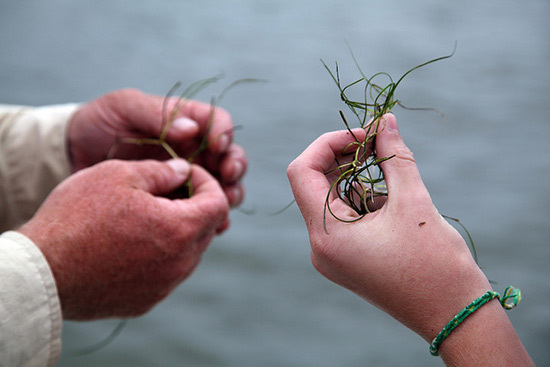Chesapeake Bay’s underwater grass abundance rises 24 percent in 2013
Scientists attribute the boost in bay grasses to the expansion of widgeon grass in saltier waters.
Underwater grass abundance in the Chesapeake Bay increased 24 percent between 2012 and 2013, reversing the downward trend of the last three years.

Because underwater grasses are sensitive to pollution but quick to respond to water quality improvements, their abundance is a good indicator of Bay health. Aerial surveys flown from last spring to last fall showed an almost 12,000-acre increase in grass abundance across the Bay, which scientists attribute to the rapid expansion of widgeon grass in the saltier waters of the mid-Bay and the modest recovery of eelgrass in shallow waters where the species experienced a “dieback” after the hot summers of 2005 and 2010. Scientists also observed an increase in the acreage of the Susquehanna Flats.
“The mid-Bay has seen a big rise in widgeon grass,” said Robert J. Orth, Virginia Institute of Marine Science (VIMS) professor and coordinator of the school’s Submerged Aquatic Vegetation Survey, in a media release. “In fact, the expansion of this species in the saltier waters between the Honga River and Pocomoke Sound was one of the driving factors behind the rise in bay grass abundance. While widgeongrass is a boom and bust species, notorious for being incredibly abundant one year and entirely absent the next, its growth is nevertheless great to see.”

Underwater grasses, also known as submerged aquatic vegetation, are critical to the Bay, offering food to invertebrates and waterfowl and providing shelter to fish and crabs. Like grasses on land, underwater grasses need sunlight to survive. When algae blooms or suspended sediment cloud the waters of the Bay, sunlight cannot reach the bottom habitat where grasses live. While healthy grass beds can trap and absorb some nutrient and sediment pollution—thus improving water clarity where they grow—too much pollution can cause grass beds to die. Indeed, poor water clarity remains a challenge for eelgrass growth in deeper waters.
Until this year, the Bay Program mapped underwater grasses by geographic zone. Now, abundance is mapped in four different salinity zones, each of which is home to an underwater grass community that responds differently to strong storms, drought and other adverse growing conditions. This reporting change “makes more ecological sense,” said Lee Karrh, program chief at the Maryland Department of Natural Resources (DNR) and chair of the Bay Program’s Submerged Aquatic Vegetation Workgroup.
“Reworking our historic data was hard work, but doing so makes it easier to understand patterns in grass growth,” Karrh said.

Comments
There are no comments.
Thank you!
Your comment has been received. Before it can be published, the comment will be reviewed by our team to ensure it adheres with our rules of engagement.
Back to recent stories